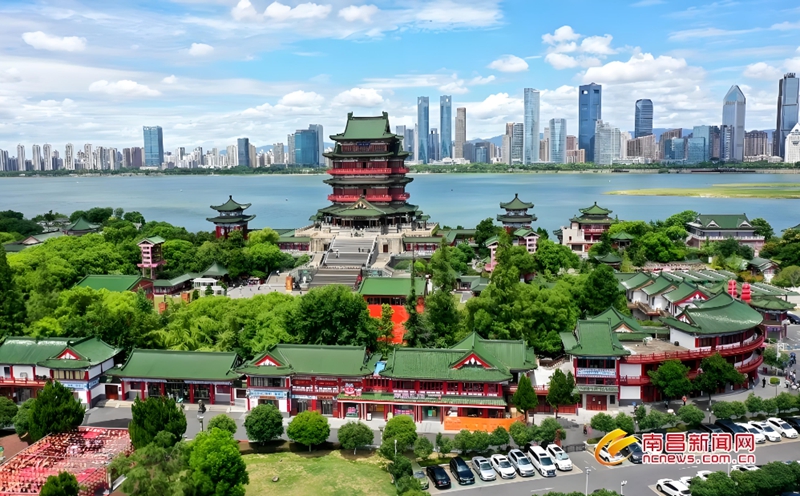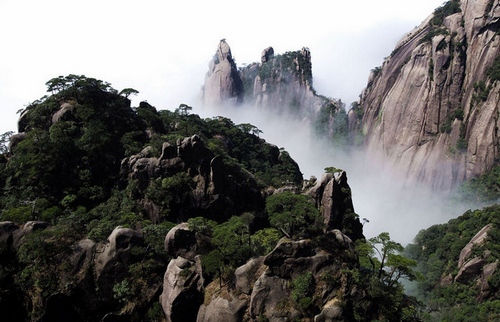Chinese Name: 江西 (Jiāngxī)
Capital: Nanchang City
Neighboring Provinces: Zhejiang and Fujian provinces to the east, Guangdong to the south, Hunan to the west, and Hubei and Anhui to the north.
UNESCO-listed Sites in Jiangxi: Mount Lushan, Mount Sanqing, Mount Longhu, Gui Peak, Wuyishan
Historical and Cultural Sites: Pavilion of Prince Teng, Jingdezhen Porcelain, ancient villages and stunning countryside viewsin Wuyuan, famous institutions like Bailudong Academy.
 JIANGXI TOP ATTRACTIONS
JIANGXI TOP ATTRACTIONS
1.Lushan Mountain
Located in Lushan City, Jiujiang, Jiangxi Province, Lushan Mountain is a historically and culturally significant mountain, bordered by the Yangtze River to the north and adjacent to Poyang Lake to the east. This mountain is dotted with numerous scenic spots and historical sites. Over the centuries, countless scholars, poets, and famous personalities have left behind an immense collection of paintings, calligraphy, and widely praised literary works.It is a famous tourist destination and summer resort in China, and in 1996, it was listed as a World Natural and Cultural Heritage site. Known for its grandeur and steepness, Mount Lu is characterized by many cliffs, cascading waterfalls, and misty clouds. Besides, most of the peaks of Lushan Mountain are above 1,000 meters in altitude, with the main peak, Hanyang Peak, standing at 1,474 meters.
2.Sanqing Mountain
Sanqing Mountain of China is located in the northeast of Jiangxi Province. It has been listed as a World Geopark and UNESCO World Heritage Site for its spectacular landscape, geological formations, and diverse wildlife. It is sometimes referred to as the “Little Yellow Mountain” because of its resemblance in natural wonder.
Sanqing Mountain is at the same time a Taoist sacred mountain with over 1,600 years of Taoist history. The mountain is named after its three highest peaks, Yujing, Yuxu, and Yuhua, with the highest Yujing Peak being 1,819.9 meters (5,970.8 feet) tall. They represent the Taoist trinity; “Sanqing” means the “Three Pure Ones.” There are over 230 ancient architectural remains and stone carvings of Taoism.
The strange peaks and rocks, ancient trees and flowers, rushing waterfalls, and the sea of clouds and fog are known as the four natural wonders of Sanqing Mountain. There are ten scenic areas with the ten greatest attractions, including the Oriental Goddess, Monster Python Peak, and Monkey King Appreciating Treasures. Cultural wonders include ancient Taoist temples and palaces.
3.Wangxian Valley
Located in Wangxian Town of Shangrao City, Wangxian Valley is a newly developed and popular tourist attraction that integrates natural landscapes of mountains, streams, and waterfalls as well as folk customs.
The scenic area has become quite popular online in recent years and was widely praised as the “Real-life Fairytale” and “Cliffside Village.” You must have been impressed by the stunning photos and videos of its towering cliffs, suspended walkways, cliffside houses, and magical night views on Youtube or Instagram. And we can promise you that all these are ture. The ancient charm and natural wonders in daytime are stunning enough. Its nighttime views are even beyond what photos and vedios can capture.
Besides its outstanding sceneries, Wangxian Valley also features peculiar rock formations, unique architecture, delicious local food, and the longest canyon rafting experience in Asia.
If you are interested in this fairyland and planning a trip there, this article will give you a help. From its key facts, top attractions, best things to do to essential travel tips, like how long to stay, where to stay, recommended routes, here’s all things to know about how to plan a Wangxian Valley tour. You can also contact us to customize your Wangxian Valley tour from Shanghai, Nanchang, Jingdezhen, Wuyuan, Beijing, and other cities in China to ensure your extraordinary travel experience.
4.Tengwang Pavilion
Tengwang Pavilion, or Pavilion of Prince Teng, of Nanchang, Jiangxi, sits at the intersection of the Ganjiang River and Fuhe River. It is an ancient landmark of Nanchang with a history of over 1,300 years. It stands as the epitome of Chinese classical architecture and is named one of the “Three Greatest Jiangnan Pavilions” together with the Yueyang Tower in Yueyang and the Yellow Crane Tower in Wuhan.
5.Wugong Mountain
Located in the west-central part of Jiangxi Province, China, Wugong Mountain is part of the northern branch of the Luoxiao Mountains, extending in a northeast-southwest direction. It spans across Luxi County in Pingxiang City, Anfu County in Ji’an City, and Yuanzhou District in Yichun City, covering a total area of nearly 970 square kilometers, with its main ridge stretching over 120 kilometers.
The main peak of Wugong Mountain, Baihe Peak (also known as Golden Peak), has an elevation of 1,918.3 meters, which is the highest peak in Jiangxi. Being a National Geopark and a National Natural Heritage site, it boasts rich and diverse scenic resources, integrating high mountain meadows, peak forest landforms, ancient altar clusters, scenic mountains, and Zen culture. If you are planning a trip there, we can customize wonderful Jiangxi tours to Wugong Mountain for you.
In 2009, Wugong Mountain was named one of the top ten “non-famous” mountains in China by Chinese National Geographic. In March 2024, Wugong Mountain was listed as a member of the Global Geopark Network by UNESCO.
6.Longhu Mountain
Longhu Mountain, literally meaning the Dragon and Tiger Mountain, is a famous resort in Jiangxi, China. It is most renowned for its three wonders, the gorgeous Danxia landform, amazing cliff tombs, and the birthplace of Taoism. Mount Longhu is regarded as a sacred mountain of Taoism and has been listed as a UNESCO World Heritage Site.





